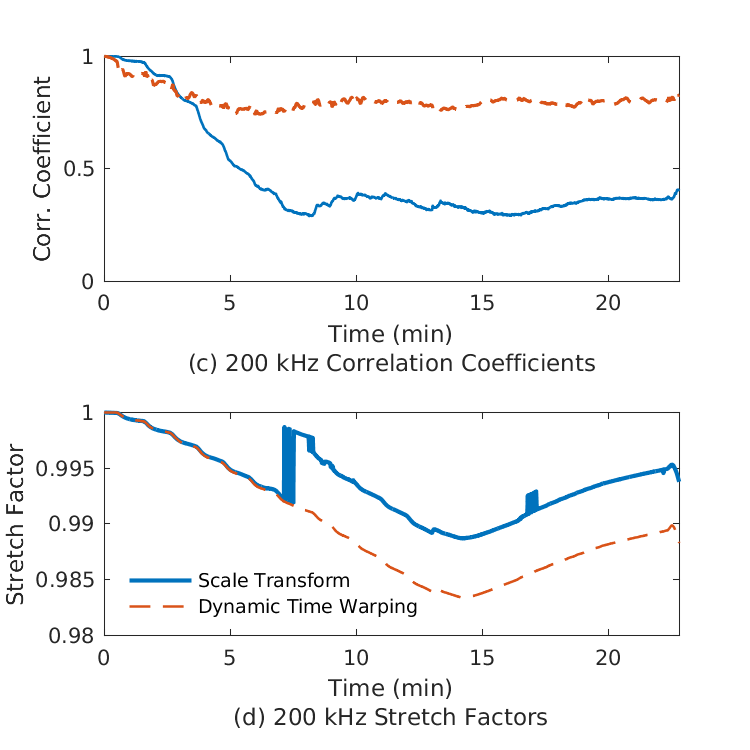Dynamic Time Warping for Temperature Compensation Repository

Summary
Guided wave Structural Health Monitoring (SHM) systems are powerful tools for detecting damage in structures like aircraft fuselages, pipelines, and bridges. However, one major obstacle persists: temperature variation. Even small temperature changes can significantly distort guided wave signals, often leading to false positives or missed damage.
Enter Dynamic Time Warping (DTW) Temperature Compensation — a robust, data-driven algorithm developed by Alexander Douglass and Dr. Joel B. Harley that aligns guided wave signals distorted by temperature, improving the accuracy and reliability of damage detection without requiring physical models or manual calibration.
This CodeOcean capsule contains a complete implementation of the DTW compensation algorithm, based on the research in:
Douglass, A. C. S., & Harley, J. B. (2018). Dynamic Time Warping Temperature Compensation for Guided Wave Structural Health Monitoring. IEEE Transactions on Ultrasonics, Ferroelectrics, and Frequency Control, 65(5), 851–861.
https://doi.org/10.1109/TUFFC.2018.2812697
❄️🔥 The Challenge: Temperature Effects in Guided Waves
In guided wave SHM, a baseline signal (recorded under one temperature) is compared to a new signal (recorded at a different time and possibly a different temperature). But temperature changes can:
- Alter wave speeds
- Shift arrival times
- Cause dispersion and mode conversion
This makes it hard to distinguish between actual damage and temperature-induced variations.
🧠 The Solution: Dynamic Time Warping (DTW)
Dynamic Time Warping is a classical algorithm used to align time series that may be out of sync—used in applications from speech recognition to motion analysis. Douglass and Harley adapted DTW for SHM by non-linearly aligning temperature-distorted signals to their baseline, allowing for meaningful comparison.
Here’s how it works:
Let:
![Rendered by QuickLaTeX.com \mathbf{x} = [x_1, x_2, ..., x_n]](https://smartdata.ece.ufl.edu/wp-content/ql-cache/quicklatex.com-3247bbe45b488ba37460cf6b911d42a1_l3.png) : baseline signal
: baseline signal![Rendered by QuickLaTeX.com \mathbf{y} = [y_1, y_2, ..., y_m]](https://smartdata.ece.ufl.edu/wp-content/ql-cache/quicklatex.com-2e30f7e61510289ac496c5f329490cd4_l3.png) : test signal (possibly at a different temperature)
: test signal (possibly at a different temperature)
DTW finds an optimal alignment path ![]() that minimizes the total warping cost:
that minimizes the total warping cost:
![Rendered by QuickLaTeX.com \[ D(i, j) = \min \begin{cases} D(i-1, j), \\ D(i, j-1), \\ D(i-1, j-1) \end{cases} + d(x_i, y_j) \]](https://smartdata.ece.ufl.edu/wp-content/ql-cache/quicklatex.com-62271bb60eaa2e2fc4488095c104c1f7_l3.png)
Where:
 is the cumulative cost matrix,
is the cumulative cost matrix, ) is a distance metric (e.g., squared error) between signal samples.
) is a distance metric (e.g., squared error) between signal samples.
Once aligned, the signals can be directly compared for damage detection—now robust to temperature changes.
🔬 Results and Benefits
In experimental tests on an aluminum plate with temperature variations between 20°C and 60°C, the DTW algorithm:
- Reduced false alarm rates
- Improved damage localization accuracy
- Required no temperature sensors or prior modeling
📦 What’s Inside the Capsule?
- 🧠 MATLAB code for Dynamic Time Warping alignment and compensation
- 🧪 Experimental guided wave datasets across varying temperatures
- 📊 Signal alignment visualizations and detection performance metrics
- 📘 Clear documentation and usage instructions
✅ Why Use This Algorithm?
- 🌡️ Temperature-robust: Accurate signal comparison without explicit modeling
- 🧠 Model-free: No physical propagation models or temperature calibration required
- 🛠️ Drop-in ready: Easily integrates into existing guided wave SHM systems
- ⚡ Lightweight and fast: Efficient computation, even for large datasets
📚 Reference
Douglass, A. C. S., & Harley, J. B. (2018). Dynamic Time Warping Temperature Compensation for Guided Wave Structural Health Monitoring. IEEE Transactions on Ultrasonics, Ferroelectrics, and Frequency Control, 65(5), 851–861.
🔗 https://doi.org/10.1109/TUFFC.2018.2812697
This capsule equips you with a robust and accessible tool to compensate for temperature effects in guided wave SHM—unlocking more reliable damage detection across seasons, climates, and real-world environments.
Anomaly Detection Dynamic Time Warping Lamb Wave Materials Nondestructive Testing Structural Health Monitoring Temperature Time Series

